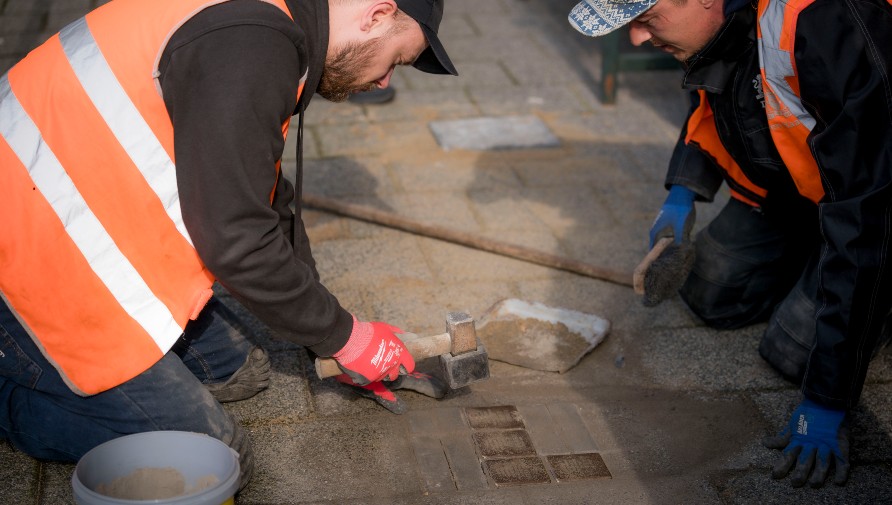Arrange a Stolperstein
Would you like to have a Stolperstein (memorial stone) placed in the public space? Request one by filling in the online form.
What it is
A Stolperstein (stumbling stone) is a square concrete memorial stone to commemorate the victims of the Nazi regime during the Second World War (Holocaust). The memorial stone has a brass plate measuring 10 x 10 centimetres. The stone states:
- the name and date of birth of the victim
- the year and place where the victim was deported
- the date and place of death of the victim
The stone often contains the name of the concentration or extermination camp as well. Stolpersteine are almost always placed in the pavement in front of the houses from which the victims were expelled and deported. This is usually the last known place of residence of the person in The Hague, if this address still exists. The Stolperstein is placed at the last address where the victims were living of their own free will. If this home no longer exists, another spot will be found (if everyone is in agreement).
How it works
Anyone can apply for a Stolperstein to be placed, for example, for a family member, friend, neighbour or acquaintance. Would you like to have a memorial stone placed in the public space? You can Begin link: apply for one here, end link. . The municipality will help choose the right spot and place the Stolperstein.

Conditions
- The applicant must have done research into the background, family relationship and family circumstances of the person for whom you are requesting the Stolperstein. Submit the research document with your request.
- Were you unable to find any descendants through your research? In that case the municipality will place a notice in the Nieuw Israëlitisch Weekblad (NIW) if:
- your application is for a victim of the Begin external link: Holocaust(External link), end external link. (Historiek.net)
- you are not a direct family member of the victim and you also did not find any direct family members during your research
If the municipality accepts your application, you need to inform the residents and neighbours that a memorial stone will be laid. Do this in writing 2 weeks before it is placed. The municipality will send you a draft letter along with the approval of your application.
Needed to apply
- research document: result of the research into the background, family relationship and family circumstances of the person for whom you are requesting the Stolperstein.
- copy of your Begin external link: proof of identity(External link), end external link.
In the online form, the municipality asks for the details of the person for whom you are requesting the stone. The following is required:
- all given names
- complete surname
- date of birth
- the last known place of residence in The Hague, including the house number (if possible, the Stolperstein will be laid at their last known place of residence)
- date of death
- place of death
Apply
Fees
The artist charges € 132 per Stolperstein to make and deliver the memorial stones. There is no fee to apply for and lay a Stolperstein. After your application is approved, contact Project Stolpersteine Den Haag. You will receive an invoice by email from the artist’s foundation (Stiftung Spuren Gunter Demnig).
How long it takes
After you apply you will receive confirmation of receipt within 2 weeks. The municipality will try to process your request within 8 weeks. Is your request incomplete or does the municipality need to check the location again? Then the assessment could take longer than 8 weeks. If a notice is placed in the NIW, this period may last longer.
The municipality will place the Stolpersteine in partnership with Project Stolpersteine Den Haag. This will not be done in the winter months, during the weekend or during the following Jewish celebrations and religious holidays:
- Pesach (Passover)
- Shavuot (Festival of the Weeks)
- Rosh Hashanah (New Year)
- Yom Kippur (Day of Atonement)
- Sukkot (harvest festival)
- Simchat Torah (the Joy of Torah)
The artist Gunter Demnig will not always attend the placing anymore.
Good to know
- The Stolpersteine art project was initiated in 1992 by the German artist Gunter Demnig. The project officially started in 2000. Demnig called the stones Stolpersteine (stumbling stones) because you literally ‘stumble’ over them with your head and your heart and you need to bend over to read the text. The artist has placed more than 100,000 Stolpersteine in at least 26 European countries and in a few countries outside of Europe. In the Netherlands there are about 12,000 stones in 275 municipalities (2023).
- Stolpersteine are placed to commemorate the following victims: Jews, Sinti and Romani people, homosexuals, dissidents (people who think differently), resistance fighters and many others. Also the victims who committed suicide for fear of the occupier.
- Did you not find any descendants of the Holocaust victim through your research? In that case the municipality will place a notice in the Nieuw Israëlitisch Weekblad (NIW) to inform any possible descendants. The municipality will share any responses to the notice in the NIW with the applicant. The municipality will pay for the costs of publishing the notice.
- The artist does not wish to judge who may be considered a victim or not.
Also see
- Begin external link: Stichting Stolpersteine(External link), end external link.
- Begin external link: Stolpersteine art project(External link), end external link.
- Begin external link: Map with Stolpersteine in The Hague(External link), end external link.
- Begin external link: Stichting Joods Erfgoed Den Haag(External link), end external link.
